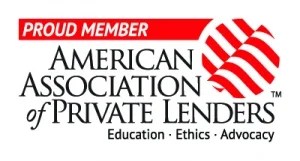Imagine getting a loan based on your property’s profit potential, not your income. If you’ve hit a wall with traditional loans’ strict income checks and DTI rules, a DSCR loan could be your solution. In this guide, I’ll show you how to qualify for a DSCR loan, perfect for real estate investors.
The Debt Service Coverage Ratio (DSCR) is a big deal for real estate investors. Tidal Loans LLC, a top DSCR lender, focuses on your property’s income, not your personal finances. This makes it easier to get loans for your investment properties, skipping the usual mortgage hurdles.
Key Takeaways
- The DSCR is key for determining loan eligibility, calculated by dividing net operating income by total debt service.
- A DSCR of 1.2 or higher typically qualifies you for a DSCR loan in Florida.
- Credit scores as low as 620 can qualify, focusing more on property cash flow than personal income.
- Extensive documentation like tax returns or pay stubs aren’t necessary; lenders primarily examine rental income.
- DSCR loans offer a high loan-to-value ratio, often allowing for larger loans than traditional mortgages.
Understanding Debt Service Coverage Ratio (DSCR)
In real estate investing, knowing the Debt Service Coverage Ratio (DSCR) is key to getting loans. The DSCR shows how much cash a property makes compared to its debt. This helps lenders like Tidal Loans LLC see if an investment is good.
What is DSCR?
DSCR is a way lenders check if a property can pay its debts. It’s the property’s income divided by its annual debt. A DSCR of 1.00 means the property just covers its debts. A ratio above 1.00 means it has extra money.
For example, a DSCR of 0.95 means the property only covers 95% of its debt payments. This shows how much income is needed to meet debt obligations.
Importance of DSCR in Real Estate Investing
The DSCR is very important for getting loans in real estate. Lenders often want a DSCR of 1.2 to 1.25. This ensures there’s money for unexpected costs or if the property is empty.
A higher DSCR means the property is in better financial shape. This makes lenders feel less risk. For instance, Sun Country Inc. had to keep a certain DSCR to meet U.S. Department of the Treasury requirements. A good DSCR can lead to better loan terms and easier approval for investors.
How to Calculate DSCR
To find the DSCR, you use a simple formula:
DSCR = Net Operating Income (NOI) / Annual Debt Service (ADS)
This formula shows the property’s income compared to its debt. It includes principal and interest payments. But, it doesn’t count expenses like management fees or repairs.
Knowing how to analyze DSCR can help investors manage their properties better. For example, it can show how buying or refinancing a property affects your finances. By using the dscr borrower criteria, investors can make smart choices about their investments and financing.
Key DSCR Loan Requirements
Understanding the basics of DSCR loans is key for investors. Knowing the dscr loan requirements helps make the application smoother. It also boosts your chances of getting approved.
Minimum Credit Score
Having a good credit score is a must for DSCR loans. Lenders usually look for a FICO score of at least 660. A higher score can help you get better loan terms, especially for more money.
This rule helps lenders see that you can handle debt well. It makes their risk lower.
Loan-to-Value (LTV) Ratio
The LTV ratio is also very important. Most lenders want an LTV of 80% or less. This means you can borrow up to 80% of the property’s value, with 20% as a down payment.
This ensures there’s enough equity to protect lenders. Meeting this requirement is key to getting your dscr loan eligibility right.
Property Eligibility
DSCR loans work for many property types. This includes single-family homes, apartments, office buildings, and hotels. Tidal Loans LLC checks these properties to see if they can pay off the loan.
It’s vital to make sure your property fits these criteria. This is how you get dscr loan eligibility and the best loan terms.
How to Qualify for a DSCR Loan
Learning how to qualify for a DSCR loan is key for real estate investors. Knowing the DSCR mortgage requirements helps. It makes the process smoother and boosts your chances of getting approved.
Preparing Your Application
Getting ready for a DSCR loan is the first step. Start by collecting accurate rental income estimates. These numbers are crucial for qualifying. Your debt service coverage ratio (DSCR) should be over 1.2 for lenders to favor you.
Also, know that lenders usually want a down payment of 20% to 30% of the property’s value.
Documents Needed
Having the right documents is essential for DSCR loan qualifications. You’ll need:
- Credit reports showing a FICO score of 620 or higher
- Property leases and rental income forecasts
- Comprehensive financial statements
Having these documents organized and ready will help speed up the process. It also improves your chances of getting the loan.
Working with a Lender
Working with a skilled lender, like Tidal Loans LLC, can make things easier. They’ll help you with the initial steps, financial documents, and final approval. Lenders often look for a DSCR of 1.25 for commercial properties.
They might accept lower DSCR ratios for single-unit properties. It’s also important to understand the loan terms. This includes repayment periods, amortization, and any prepayment penalties. This way, you’ll meet all dscr mortgage requirements without trouble.
Benefits of DSCR Loans for Real Estate Investors
DSCR loans have many benefits for real estate investors. They offer flexibility, not needing personal income verification. Investors qualify based on the property’s rental income. This is great for financing multiple properties or big investments.
These loans also work with many property types. Investors can use them for single-family homes, multi-unit buildings, and commercial spaces. This means more opportunities without being limited by personal income.
DSCR loans also have high financing limits, from $2 million to $5 million. They require a down payment of about 20% of the property’s price. This makes it easier to invest in big properties without a huge upfront cost. Plus, the loan-to-value ratios are 75% to 80%, making them attractive for using existing assets.
DSCR mortgage benefits include faster application and closure times. This is a big plus in fast-paced real estate markets. Plus, they don’t need detailed personal income documents, making the process simpler.
DSCR loans also let investors use funds for multiple properties at once. This is good for both new and experienced investors. DSCR loans are designed for long-term investment goals, helping investors grow their portfolios.
Types of Properties Eligible for DSCR Loans
DSCR loans are great for many property types. They help investors with single-family homes or big commercial spaces. Here are the main types of dscr eligible properties and what to consider.
Residential Properties
Most DSCR loans are for homes like single-family houses or apartments. These loans look at the property’s income, not the borrower’s. This makes getting a loan easier. Plus, they often have a fixed rate for thirty years, which is good for long-term plans.
Commercial Properties
Commercial spots like offices or hotels can also get DSCR loans. These need a close look at how much money they make. Loans usually want a DSCR of 1.25 and an LTV of 80% or less. This ensures the property makes more than it owes.
DSCR loans for commercial properties can be up to $3 million. Lenders like Tidal Loans LLC offer custom solutions.
Special Use Properties
Special use properties include medical offices or warehouses. The rules for these are similar to other properties but might need extra checks. For example, how the industry works and the team’s experience can affect the loan.
Investors pick DSCR loans for these because they’re easy to get and have flexible terms. For more info on DSCR loans and who can get them, talk to financial experts and lenders.
Common Pitfalls and How to Avoid Them
Debt Service Coverage Ratio (DSCR) loans are popular among investors. They seek financing for their rental properties. But, there are common pitfalls that can risk your investment if not managed well.
Ensuring Accurate DSCR Calculation
One big mistake is an inaccurate DSCR calculation. A higher DSCR means the property’s income covers debt well. But, if you overestimate Net Operating Income (NOI), the DSCR looks better than it is.
A DSCR ratio of 1.0 or higher is safe for most lenders. But, wrong calculations can show a misleading ratio. For example, if you underestimate total debt service, you might face financial trouble.
Avoiding Overestimation of Rental Income
Another mistake is overestimating rental income. This impacts the DSCR ratio a lot. For instance, using short-term rental income can make the DSCR ratio vary a lot.
Getting a 12-month rental ledger from a property management company is key. It shows consistent rental income. This gives lenders a reliable financial picture. Ignoring property condition and market value can also lower the DSCR.
Understanding Prepayment Penalties
Many overlook DSCR loan prepayment penalties. It’s important to understand these penalties. Early loan settlements can cost a lot. Talk to lending experts to avoid these costs.
Ignoring credit history, not keeping proper documents, and treating rental property as a hobby can also cause problems. These can lead to higher interest rates or stricter loan terms.
Good financial practices and careful research are key. They help make the most of DSCR loans and avoid common pitfalls in real estate.
Tips for Securing the Best DSCR Loan Terms
Getting the best DSCR loan terms can really boost your investment’s earnings. To get favorable terms, you need a good plan and to know the dscr lending rules. Here are some tips to help you get better loan terms:
Improving Your DSCR Ratio
First, boosting your DSCR ratio is key. Lenders like a DSCR over 1, showing you can pay your debts. To do this, increase your rental income and cut down on expenses. Look at your costs and find ways to save money.
Lowering your interest rates also helps your DSCR. A higher DSCR ratio means lenders see you as a better risk. This can lead to better loan terms for you.
Shopping Around for Lenders
It’s smart to look at different lenders for the best terms. Compare things like interest rates, loan-to-value ratios, and fees. This gives you power to get a better deal.
Building strong relationships with lenders can also help. They might offer you better terms because they know you. Keep up with market trends and other financing options. They might have terms that fit your investment goals better.
Negotiating Loan Terms
After finding lenders, it’s time to talk about loan terms. Knowing what you want in your loan helps you negotiate. Explain your investment plan and how it fits with their rules.
Use the offers from other lenders to your advantage. Knowing the market can also help you negotiate better. Aim for terms that meet your needs now and in the future.
Getting the best DSCR loan terms takes work and smart choices. Improve your DSCR, shop around, and negotiate well. This way, you’ll get terms that match your investment goals.
DSCR Loan Process: Step-by-Step Guide
The DSCR loan process might seem complex, but breaking it down helps. It makes the journey clearer. By focusing on the main steps, you’ll know what to expect from start to finish.
Initial Information Gathering
The first step is to gather key details about the property and your finances. You need to understand the property’s ability to make money. For the dscr mortgage application, collect data on rental income, expenses, and any empty units. This info is the base for your DSCR (Debt Service Coverage Ratio).
Financial Documentation
After getting the property info, it’s time for more detailed financial documents. You’ll need rental agreements, income statements, and appraisals. If you’re applying for a multifamily home or commercial property, make sure all records are accurate. Lenders, like Tidal Loans LLC, will check if the property’s income is at least 25% more than its debt (DSCR of 1.25).
Loan Approval and Closing
The last step is loan approval and closing. If your DSCR meets the lender’s standards (usually 1.2 to 1.5), you can move forward. This includes underwriting, where lenders check your application’s risk and financial health. If you pass, you’ll get to the closing, making your investment financing secure.
Knowing the dscr loan process helps real estate investors find the best financing. By following these steps, the journey from dscr mortgage application to approval is smooth and quick.
Conclusion
DSCR loans are a key tool in real estate financing. They let investors use property income instead of personal credit for loans. This method helps those with lower credit scores and focuses on income, leading to financial freedom in real estate.
Knowing about the Debt Service Coverage Ratio (DSCR) is crucial. A DSCR of 1.25 or higher is usually needed to qualify. This shows lenders the property’s income is more than its debt, making it a stable investment.
DSCR loans are available for many property types, from homes to commercial spaces. This gives investors strong opportunities.
The DSCR loan process includes calculating the DSCR, providing bank statements, and meeting certain requirements. Working with lenders like Tidal Loans can make it easier. They help you avoid problems and get good loan terms, helping you succeed in real estate.
For those interested in DSCR loans, understanding them well is the first step. With the help of experienced lenders, getting a loan is easier. This makes owning and investing in property a real possibility.


